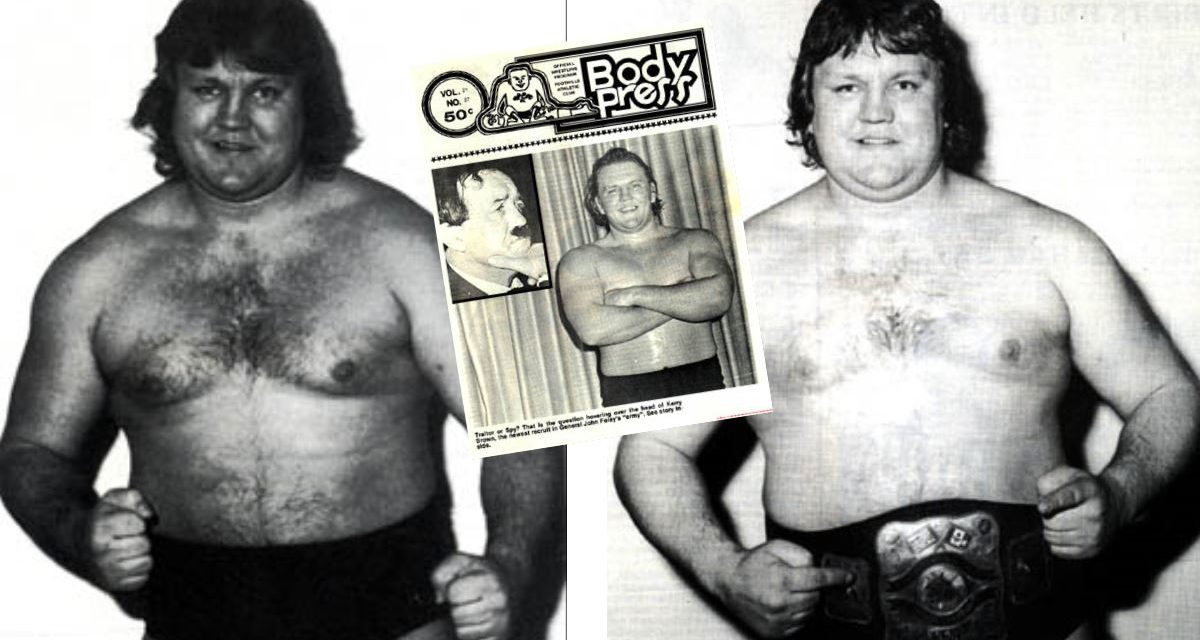These days, it seems just about anyone can do a shoot interview. From the big names of pro wrestling, to the lesser lights, it’s an ‘in’ thing to do.
Neither a big name nor a nobody, Winnipeg’s Kerry Brown definitely falls somewhere in the middle. And in a similar vein, his shoot video falls somewhere in between good and bad.
It’s a co-production between Brown and fellow Winnipeg grappler Rob Stardom, shot in February. To call it an amateur production is a bit of an understatement. Basically, the director (Stardom) turns on the single camera and asks questions of ‘The Pit Bull’, who is lazily relaxing on a couch. Not a lot of thought seemed to be put into the surroundings either: Someone talks from off-camera, the phone rings, etc.
Yet for anyone with even a passing knowledge of Brown’s career, it’s an interesting tape to watch.
He broke into pro wrestling through his uncle, Bulldog Bob Brown, who quite simply asked him if he wanted to be a wrestler. The Bulldog had a hand in training his nephew, but it was primarily Ricky ‘The Gladiator’ Hunter, Puppy Dog Peloquin and Tony Condello who polished him up for action in Winnipeg. After a debut in 1979, it was off to the Kansas City territory, where his uncle had established a bulkhead.
Brown’s recollections of Kansas City, and his early days in the game, are among the most interesting topics on the tape. His uncle was a “stooge” for the K.C. office, and the younger Brown had to fight hard to get out from under a similar label.
Many different names are discussed, from Harley Race to Pat O’Connor to Eddie Gilbert.
For the Canadian fans, however, it’s Brown’s stories of Stampede – including his Stu Hart impression – that make the tape.
Stu Hart “was the best promoter I ever worked for in my life,” explains Brown. He talks about the money he was making in Stampede, a healthy $600 a week in the early 1980s, as well as the behind-the-scenes stories one expects in a shoot video, including details on the notorious St. Regis Hotel in Calgary and a great (if mean-spirited) rib pulled on Jason the Terrible (Karl Moffatt).
Brown even goes into a couple of the silly angles he was in while working in Stampede Wrestling. There was the very short-lived gay tag team Midnight Cowboys with Rip Rogers and Brown dressing up as a woman to attack Chris Benoit.
Of course, the Hart boys are dissected in detail. Kerry’s got a lot of respect for Bret, who once said that Brown was one of the Top 5 workers he ever faced. The flipside is Bruce Hart, who takes a verbal beating. Owen is not treated with any sort of reverence, either, which is refreshing but may also upset some viewers.
Speaking of upsetting, Brown’s language is laced with profanities throughout the tape, and he proudly boasts of his amorous conquests over the years, his drinking and touches on his own recreational drug use.
Brown also takes the viewer under his alter ego of Rick Valentine into Montreal (Dino Bravo’s death, Eddie Creatchman), the Maritimes (“Leo Burke is a mastermind in this business”), Japan (fighting Antonio Inoki), and down south into Puerto Rico (Bruiser Brody’s death, teaming with Eric Embry).
The stories from South Africa will definitely stay with the viewer, though, especially the fight with Sailor White and the horrific car accident he details.
The viewer also learns about Brown’s life away from the ring over the last number of years, and the reasons behind his return to action around the Prairies.
Brown’s memory is hardly perfect, and some of the facts he describes seem somewhat embellished – and some are downright incorrect.
In the end, it’s got the feel of sitting around a bar with Kerry Brown (a place he admits to having frequented more than a few times) while he tells story after story for two and a half hours.
The Kerry Brown shoot video is available for $15.00 Canadian, postage included, from Robert Maxwell, 40 Teakwood Ave., Winnipeg, MB, R2V 2M9. You can email robstardom@hotmail.com for more details.
RELATED LINKS
- Nov. 11, 2009: Kerry Brown tribute show touches family, peers
- Sep. 28, 2009: Guest column: I remember … Kerry Brown
- Sep. 11, 2009: Column: My friend, Kerry Brown
- Sep. 10, 2009: Kerry Brown dead at 51

